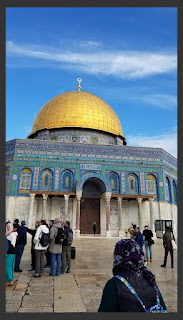Friday’s profound journey
Our journey from Tiberias back to Bethlehem, through the heart of the West Bank, was one of great profundity. We had an amazing encounter with the Samaritan community on Mt. Gerizim. There are only about 800 Samaritans left in the world; we met the high priest and his 24 year-old nephew, who helped translate for his uncle. The Samaritans are the remnants of two Northern tribes of Israel (Ephraim and Manasseh, sons of Joseph), along with Northern Levites. They are not Jews, who descend from the tribes of Judah, Benjamin, and southern Levites. The Samaritans have their own version of the Torah that differs significantly from the Jewish version. Each side claims to have the more original text. Next we visited the Well of Jacob in Nablus, traditional site of the encounter between Jesus and the Samaritan woman in John 4. Our archaeological site for the day was ancient Sebaste, which had something from every era, in reverse chronological order: ruins of a Byzantine Church, Herodian era Roman forum and amphitheater, and a circular Hellenistic tower. The most ancient part was at the top of the hill: ruins from the biblical city of Samaria, capital of the Northern Kingdom of Israel from about 900 BC until it was destroyed by the Assyrians in 721 BC. This is where the prophet Elijah, King Ahab, and the infamous Queen Jezebel battled it out over which god was stronger: Yahweh or Baal. Our last stop of the day was in Ramallah, administrative headquarters for the Palestinian Authority. We drove past the impressive white administrative building which also houses the tomb of Yasser Arafat. We had an incredibly insightful hour and a half with Father Jamal Khadar, a Palestinian Catholic priest who provided profound insights into the current political situation. This was a fitting end to a day where we saw numerous Jewish settlements deep in the West Bank, along with the special roads, walls, and infrastructure built to support them.








Your note that the "Samaritans have their own version of the Torah that differs significantly from the Jewish version" is interesting. I would like to hear more on the areas they are different. This is all so interesting.
ReplyDeleteThe main difference has to do with the location of the Temple. The Jewish version of the Torah leaves it open, allowing later books (Samuel and Kings) to specify that God wants his Temple in Jerusalem. The Samaritan version collapses the first two commandments into one, allowing the 10th commandment to read “You shall build your Temple on Mt. Gerizim.” Both versions are attested among the Dead Sea Scrolls! Samaritans don’t accept any books outside the five Books of Moses, so they don’t care what the Book of Kings has to say.
Delete